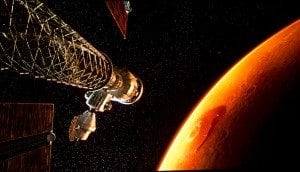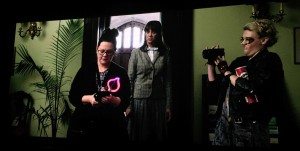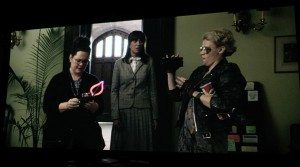HDR Performance on the VW5000ES
HDR is new stuff. And it changes a whole lot of things. But the first thing worth pointing out is that HDR - High Dynamic Range calls for having a very bright display.
How bright? Well bright enough that only a few of the most expensive currently shipping LCDTVs (or OLEDTVs), meet the base standard defined as 1000 NITS brightness. We projector folks talk in lumens as a measure of brightness of a projector, or ft-lambers as a measure of brightness off the screen.

4K HDR content - there's nothing quite like outer space imagery to show off a great projector
The typical LCDTV out there produces 300 - maybe 550 NITS. A 5000 lumen projector like this Sony, produces something in the order of 400 NITS on a 100" diagonal, normal gain screen.
Don't Panic!
HDR is about - simplest explanation: There are whites, and then there are those extremely bright moments - explosions on screen, flashes etc. HDR puts that pop back in, that has been lost to us home viewers all these years. But, there are sacrifices to be made. I'm not engineer enough (or at all) to really explain the finer points, so these are my impressions.
I've now worked with six HDR capable projectors (3 Sonys, 2 Epsons and a JVC, more coming).
Because HDR calls for a minimum level of brightness (not that the content is being delivered consistently - not all UHD discs assume 1000 NITS brightness, but that is by far the most prevalent), the emphasis of HDR is very different than SDR.
With good old SDR (everything we've been used to (standard dynamic range), the more brightness your display, the brighter the entire picture, but with HDR, the more brightness your display, the more difference between the brightest, and the middle brightness parts and the low brightness parts - that is, more dynamic range.
Sounds great, but if you don't meet the brightness levels demanded (and almost nothing does so far), you get mid brightness areas say person's face in a moderately lit room, that come across too dark.
How much too dark?
Well, best I can tell, the closer you get to the 1000 NITS, the close you get it it not seeming too dark at all.
I noticed this difference, when going back and forth between this Sony putting out just shy of 5000 lumens, and a pixel shifting HDR capable Epson 5040UB with less than 2000 lumens to work with.
Check out these two images - and look at the brightest area in the center, faces, clothes (especially lower down in the image) and the walls. You can see a dynamic difference.

Ghostbusters scene HDR - VW5000ES - richer colors, more dynamic than less powerful Epson 5040UB below - taken with iPhone 6, HDR
And for the most stunning difference, look at the bright "PKE meter", and then look at the can of Pringle's chips.

Ghostbusters HDR from Epson HC5040UB - lower overall dynamics due to less "horsepower, than Sony 5000ES (Epson putting out about 1400 lumens vs 4400+ on Sony
Now both images are more dynamic looking than the SDR version of the movie, but we're seeing some real differences here. It's not the calibration (neither projector was calibrated at the time, so don't try to compared color accuracy), rather I believe what you are seeing is what having more maximum brightness brings to the party.
As the Sony VPL-VW5000ES is easily the brightest home theater projector with 4K and HDR, that gives it a leg up on everything. BTW, Even the Epson looked great, but the differences are pretty dramatic. (Hey, the Sony is only 20 times the price, but then, if you want the best..).
Enough!
Last night my wife and I watched the Epson 5040UB handle Deepwater Horizon. Amazing dynamics, I was blown away, I just wish I still had the Sony here, because that would have been something else completely! I mean "Next Level!"
18GHz HDMI 2.0, HDCP 2.2
Just a quick note here, to support all the future possibilities of 4K, 60fps 12 bit color depth, 4:4:4, etc., the spec needs HDMI that can pass 18 Ghz. This Sony has it. Other than the Sony, and the JVC's everyone else seems to be doing just 10 Ghz. Folks, we may never see Blu-ray UHD content that needs the extra, just like after 10 years we never saw 12 bit color or 10 for that matter on Blu-ray movies, even though the Blu-ray spec had always supported it.
Great to have, the wider bandwidth though, no more needs to be said, since this is maximum future proof available today.
The standard going forward for HDMI is 2.0 and the copy protection on Blu-ray UHD is 2.2. This is standard stuff for any 4K capable projector planning to handle 4K commercial content. Even the least expensive 4K capable projectors are HDMI 2.0 and HDCP 2.2.
Laser Light Engine
There are many benefits, they last years and years, the color remains consistent for years, the brightness dims slowly over years, not months, etc. And there are other aspects beyond my ability to explain relating to color handling and perception. Let's just say that the future is lasers, and that means far less hassles, and a better picture.
Sony specs the laser light engine at a healthy 20,000 hours - folks that's 40 hours a week for a decade! If you are watching that much, and aren't a projector reviewer, you probably need to get outside more!
Sony is happy to explain on their site all kinds of wondrous tech details about laser performance. But, at the end of the day, there's the advantages I mentioned, and a great picture. I'm sure there are a few potential VW5000ES buyers into the finer points - such as some Hollywood producers and colorists, and directors, and others, but for most who just want the most awesome thing around, you now know enough.




